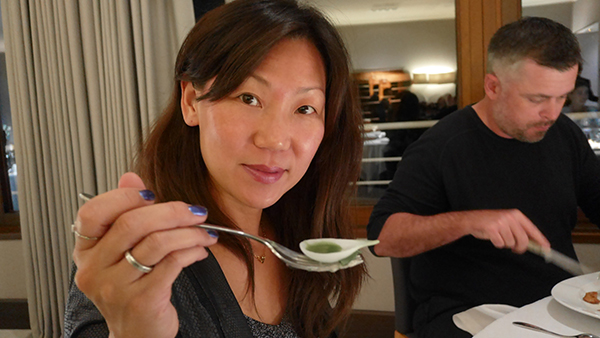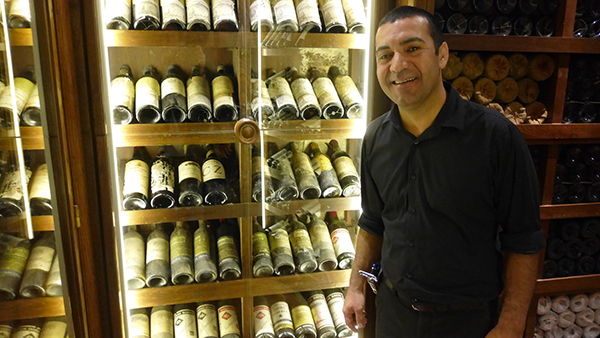Spain's Balancing Act

Can you drink Spanish wine with Spanish food? Of course, you can, but I found myself asking the question every time I had dinner with some Hong Kong friends two weeks ago in San Sebastian, Spain. We spent the weekend in one of Europe’s great gastronomic cities and we were lucky enough to eat in some of the best restaurants in the area including two three-Michelin-starred restaurants: Azurmendi and Martin Berasategui. We also ate in more casual restaurants from such as the great wine restaurant Rekondo and the fun bar of Zeruko, which has some of the best pinchos, or tapas, in Spain.
What I enjoyed about all the food is the obvious quality of the ingredients used in each place. It doesn’t matter if it’s a simple bar or a great restaurant, the food is so precise and crystal clear. It seems happily far away from the wacky food of Spain’s molecular food craze years ago.

But the biggest challenge with every meal I found on this trip was finding wine to go with the food. This was less of a problem with the whites since I focused mostly on albariños and old white Riojas. But the reds were a real problem. Most of the vintages on offer at these restaurants were from the 2009 and 2010 vintages with a focus on ripeness. A number of the wines were just too alcoholic at more than 15 percent alcohol. They literally burned your palate with the food. Most of my friends from Hong Kong, particularly the women, found the wines overdone and undrinkable.
One Spanish sommelier explained his views on the subject: “These are wines from a period when some people were trying to make wines for one particular palate and very ripe and alcoholic wines were in fashion. The winemaking style overwhelmed the wines’ true identity. But there’s a new generation of winemakers in Spain who are looking for a different direction, and trying to make wines that reflect their terroirs.”

It’s obvious who he was talking about but I don’t want to get into it. I am just happy that he believes that a change is in the works. I had the same feeling after tasting about 600 wines in Spain last year. I wrote, like others, that Spain needs to go back to its roots and return to making balanced and fresh wines that offer maximum drinkability and ageability.
This all was underlined during a dinner at Rekondo restaurant on the last day of my quick visit. The traditional Basque restaurant has an exceptional wine list, and we were lucky enough to persuade them to let us drink a few ancient bottles including a 1968 Rioja Alta Rioja Gran Reserva Especial, a 1952 CUNE Viña Real Gran Reserva and a 1949 CUNE Viña Real Gran Reserva.

Here are my tastings notes for the wines:
1968 Rioja Alta Rioja Gran Reserva Especial 890
The deep color ruby is impressive with an amber hue to it. Lots of dried fruits such as raisins as well as orange peel, cedar and tobacco. Medium body and very layered palate. Vibrant and fresh with an intense underlying acidity. A vivid mature wine. Drink now. 96 points.
1952 CUNE Viña Real Rioja Reserva Especial
This old wine has a superb texture with fine tannins and vibrant acidity. Aged silk. Lots of violet, black truffle and dark fruit character. Such balance and beauty still. 97 points.
1949 CUNE Viña Real Rioja Reserva Especial
What strikes you about this legendary wine is the seamless texture of the wine from a combination of ultra-fine tannins and bright acidity. The finish goes on for minutes as you taste the black truffle and blue fruit character with hints of caramel. A fascinating wine. 99 points.

Besides showing how amazing these great old Rioja are, the bottles point out how high alcohol and concentration are not the way forward for Spain. “We have a history to follow for making great wines in Spain and we should not diverge from that,” said Martin Flea, the man in charge of the amazing cellar of the restaurant Rekondo.
I have to agree, and I hope I will find many balanced and beautiful Spanish wines tasting in Spain this summer.
Photos from top to bottom: colorful lobster bisque at Azurmendi; creative and precise cuisine at Martin Berasategui; Martin Flea of Rekondo restaurant with old Riojas; old bottles of Rioja; and amuse-gueule at Azurmendi in a humorous picnic basket
– James Suckling, CEO